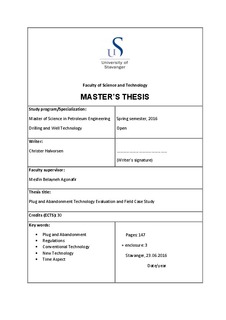| dc.description.abstract | In the North Sea, the average field age is increasing and a large number of wells needs to be plugged and abandoned in the future. P&A is regarded as an operation with no financial returns and is associated with significantly high costs. With a continuous increase in the number of wells that require abandonment and a falling oil price, the major focus for the oil industry is reducing costs while ensuring safe and reliable plugging of wells.
The conventional method for placing a plug in a cased hole with no external barrier has required section milling of the casing, underreaming the open hole, and placing a balanced cement plug. The conventional method is time-consuming and costly, and is associated with several challenges and risks concerning Health, Safety and Environment (HSE). To reduce the cost and increase the efficiency of P&A operations, more attention has been directed towards the subject of P&A in recent years.
This thesis has examined and presented the conventional section milling technology along with its limitations and challenges, and compared it with new technology’s with respect to time and scope. The main focus has been the new perforate, wash and cement (PWC) technology developed by HydraWell, and its advancement in the P&A operation. A case study comparing the conventional section milling operation with the PWC operation has been performed. Other investigated alternatives include reverse/upward section milling and plasma-based milling.
This thesis also gives an insight into the process of plugging a well, including regulations and requirements, plugging materials, placement techniques, cement evaluation tools and challenges with the P&A process.
The main findings revealed that most of the challenges with the section milling operation can be led back to the generated swarf. The case study revealed that the installation of the reservoir and secondary barrier was the most time-consuming part of the P&A operation. It also revealed that by applying the PCW technology, the operational time used to install the reservoir and secondary barrier could potentially be reduced by 73 % compared to the section milling operation. Considering the impressive scope ahead, the PWC technology has potential to reduce cost significantly for operating companies and national authorities in the future. | nb_NO |
